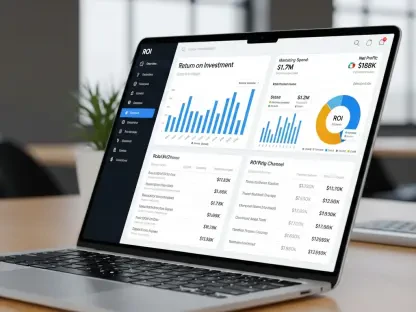In an era where data reigns supreme, imagine a B2B enterprise struggling to forecast sales amidst a sea of fragmented customer information, missing out on millions in potential revenue due to an inability to transform vast amounts of transactional data into actionable strategies. This scenario is all too common as businesses grapple with these challenges. In 2025, the B2B sector stands at a critical juncture, with e-commerce sales in the US alone reaching an estimated $304.2 billion in the second quarter, according to the US Census Bureau. Yet, the challenge lies not in the abundance of data, but in harnessing it effectively to predict growth and outpace competitors. This report delves into how B2B data analytics serves as a transformative tool, offering insights that can redefine revenue streams, streamline operations, and enhance customer relationships in a highly competitive landscape.
Understanding B2B Data Analytics: A Foundation for Growth
B2B data analytics encompasses the systematic collection, integration, and analysis of data derived from business-to-business interactions and transactions. This includes everything from wholesale orders to enterprise contracts, providing a comprehensive view of sales dynamics and operational workflows. Unlike traditional methods, modern analytics tools consolidate data from both online and offline channels, creating a unified perspective essential for informed decision-making.
The significance of this approach in today’s commerce environment cannot be overstated. Moving beyond mere static reporting, B2B analytics now delivers actionable insights that pave the way for predictable growth. Enterprises are shifting focus toward real-time dashboards and predictive models, enabling them to anticipate market shifts and customer needs with unprecedented accuracy, thus securing a strategic edge.
A distinguishing factor of B2B analytics is its emphasis on account-level insights, longer sales cycles, and complex buying processes involving multiple stakeholders. Unlike B2C models that prioritize high-volume individual transactions, B2B operations often deal with fewer but larger deals, where a single contract can significantly impact quarterly results. This complexity demands tailored analytical approaches to navigate the intricacies of multi-person decision-making and extended timelines.
The Strategic Impact of B2B Data Analytics on Business Growth
Revenue Acceleration through Targeted Insights
Data analytics in the B2B realm empowers companies to identify high-value customer segments, enabling a focused approach on accounts with the greatest growth potential. By predicting reorder patterns, businesses can anticipate client needs, ensuring timely engagement and sustained revenue streams. Furthermore, analytics aids in optimizing pricing strategies by highlighting areas where margins can be increased without sacrificing competitiveness.
Advanced predictive tools also forecast sales outcomes, estimating the likelihood of deal closures and identifying accounts at risk of churn. Such foresight allows sales teams to intervene proactively, safeguarding revenue. A notable example is Decathlon, a global sporting goods retailer, which leveraged a leading e-commerce platform to accelerate reporting by 50% and enhance data analysis by 60%, resulting in clearer visibility into sales trends and performance metrics.
Operational Efficiency and Cost Reduction
Beyond revenue growth, B2B analytics significantly enhances operational efficiency by automating manual reporting processes. Real-time dashboards replace outdated weekly summaries, minimizing errors and freeing up teams to concentrate on strategic analysis. This automation translates into substantial time savings and improved accuracy across departments.
Analytics also provides immediate visibility into inventory and supply chain dynamics, facilitating dynamic stock allocation and reducing the need for excess inventory. Additionally, self-service insights empower customers to access order histories and product details independently, lowering the cost-to-serve. A case in point is DECKED, a manufacturer of storage systems, which utilized live data capabilities to streamline operations, making swift, informed decisions that fueled business expansion.
Transforming Customer Experience in B2B
Modern B2B buyers demand experiences that mirror the personalization and ease of consumer shopping. Analytics enables this by tailoring interactions at the account level across multiple touchpoints, ensuring relevance and engagement. Predictive recommendations based on purchase history further drive cross-sell and upsell opportunities, enhancing order values.
Proactive customer success management is another critical benefit, as analytics identifies potential issues before they escalate, preserving long-term contracts vital to B2B revenue. Future Glass, for instance, adopted specialized B2B tools to offer custom catalogs and unique pricing, achieving a remarkable 340% increase in sales and an 83% boost in conversions, demonstrating the power of seamless, data-driven customer interactions.
Key Challenges in Implementing B2B Data Analytics
Implementing B2B data analytics is not without hurdles, with data silos across disparate systems often obstructing a unified view of operations. Such fragmentation can derail decision-making, necessitating robust technological solutions and governance frameworks to integrate data effectively. Platforms offering real-time analytics capabilities can significantly ease this process.
Resistance to change among employees poses another barrier, as traditional methods may be preferred over new tools. Addressing this requires comprehensive change management, including clear communication of benefits and extensive training to foster adoption. Technical integration complexities also arise, demanding skilled support to ensure smooth data flow between enterprise systems, while difficulties in measuring ROI call for predefined metrics to quantify the impact of analytics investments.
A successful example of overcoming these challenges is Schleich, a toy manufacturer, which improved checkout abandonment rates by 31% and increased orders by 25% through effective analytics integration. By prioritizing ease of system compatibility, the company saved considerable time, highlighting the importance of strategic planning and platform selection in navigating implementation obstacles.
Building a Robust B2B Analytics Strategy for Enterprises
Assessing Data Maturity and Capabilities
The foundation of a strong analytics strategy begins with evaluating an enterprise’s current data maturity. This involves auditing existing data sources to assess quality and accessibility, ensuring all relevant information from sales to customer interactions is accounted for. Identifying gaps at this stage prevents overestimation of capabilities and sets a realistic starting point.
A thorough review of the technology stack is equally essential, examining how well current tools and systems integrate with broader enterprise platforms. Additionally, assessing team skills reveals needs for training or hiring to support advanced analytics. This comprehensive baseline allows businesses to address deficiencies and build toward a data-driven future.
Defining Success Metrics and KPIs
Clear goals and key performance indicators are vital for measuring the success of analytics initiatives. Revenue-focused metrics, such as conversion rates and customer lifetime value, provide insight into financial impact, while efficiency indicators like inventory turnover highlight operational gains. Customer satisfaction scores, including Net Promoter Score, gauge improvements in buyer experiences.
Setting specific targets ensures that analytics efforts align with business objectives, driving tangible outcomes. Dermalogica, a skincare brand, exemplifies this by leveraging unified systems to achieve a threefold increase in reorder frequency and a 23% rise in conversions, with high customer satisfaction ratings underscoring the value of well-defined metrics.
Selecting and Implementing the Right Analytics Platform
Choosing an analytics platform is a pivotal decision, with options to build custom solutions or purchase established systems. Buying often offers faster deployment with built-in best practices, while integration capabilities with existing CRM and ERP systems are crucial for seamless data flow. Scalability must also be considered to accommodate growing data volumes and analytical complexity.
Dollar Shave Club’s transition to a robust platform reduced maintenance resources by 40% and expanded global reach to 100 million users. This shift enabled rapid international site deployment, illustrating how the right technology choice can alleviate operational burdens and support expansive growth strategies.
The Future of B2B Data Analytics: Trends and Opportunities
Looking ahead, B2B data analytics is poised for significant evolution, with unified commerce intelligence emerging as a key trend. Enterprises increasingly seek a single analytical layer that integrates B2B and direct-to-consumer operations, ensuring consistent decision-making across channels. This holistic view enhances predictions and profitability assessments.
Another development is the rise of self-serve customer analytics, where B2B buyers access predictive dashboards for account-level insights. Gartner forecasts that by 2027, 50% of business decisions will be augmented by AI, with organizations prioritizing AI literacy seeing 20% higher financial performance. Early adoption of these advanced tools positions companies for a competitive advantage in a rapidly changing market.
Reflecting on Findings and Future Outlook
Looking back, this exploration of B2B data analytics revealed its profound capacity to reshape enterprise growth through enhanced revenue streams, operational efficiencies, and superior customer engagements. The journey underscored persistent challenges like data silos and integration complexities, yet showcased how strategic approaches and platform choices mitigated these issues effectively.
Moving forward, enterprises should prioritize the development of a clear analytics roadmap, beginning with an honest assessment of current capabilities and setting measurable goals. Investing in scalable platforms that integrate seamlessly with existing systems will be crucial. Continuous learning and adaptation to emerging trends, such as AI-driven decision-making, must become integral to maintaining a competitive edge in the evolving B2B landscape.









